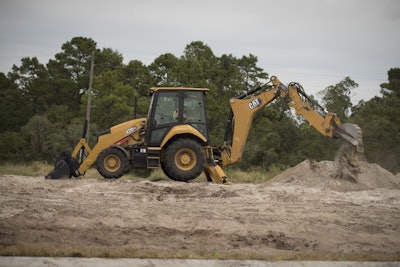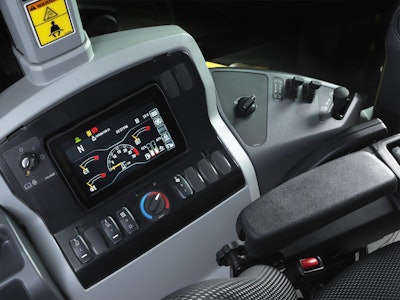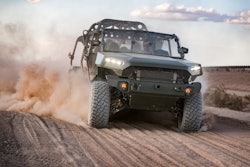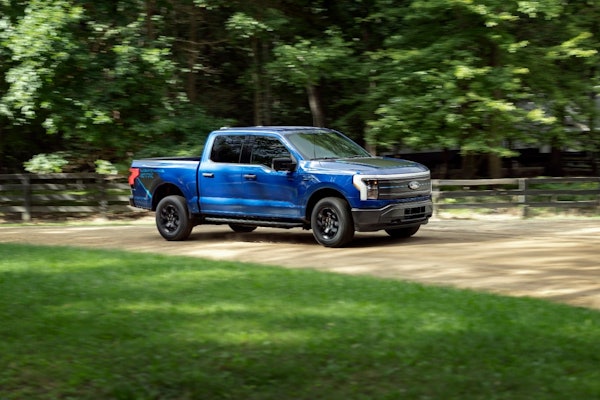The 420 is Caterpillar’s flagship backhoe, it’s the most popular due to the versatility of thes size and how well balanced it is. And because of that it’s really the machine that Cat bases the rest of its lineup upon. And an all-new model just hit the market. But along with this updated 420, Cat has introduced a new premium version of this machine that is all about adding just a bit more in a few key areas.
The new Cat 420 and 420 XE are the anchors of Cat’s new lineup of backhoes so let’s discuss what’s new with these two backhoe models but also discuss what sets the 420 XE apart. We’ve got the full breakdown on all the updates and improvements to these new machines and the differences between them in the video below.
New Naming
Let’s start with the new name of these machines. In 2017 Cat started removing letter suffixes from its machine model names. So while the previous generation of backhoes was denoted by the F2 suffix, that has been dropped from the new model names.
That means that the new 420 and 420 XE backhoes replace the 420F2 and 420F2 IT model.
Beyond a new name, the primary updates on the new 420 backhoes are a new engine, a new hood design, improved performance and better fuel efficiency.

One of the first changes you’ll notice is that new hood design. Cat has reshaped it with a sharper slope from the cab to the loader to provide you with more visibility to the bucket or whatever tool you’re currently using.
New C3.6 engine
Cat has replaced the C4.4 engine that powered the F2 Series of backhoes with the new C3.6 engine. The engine provides 92 horsepower on both the 420 and 420 XE and meets Tier 4 Final emission standards through a service-free Selective Catalytic Reduction (SCR) emission solution with diesel exhaust fluid (DEF) and diesel particulate filter (DPF).
Cat says this new engine provides quicker acceleration while roading and lowers operating costs through an improvement to fuel efficiency of 10 percent.

“Not only is [this engine] going into our backhoe loaders…but it’s also going into a few other BCP products, such as our compact wheel loaders and our small truck type tractors,” says Cat backhoe product specialist Dustin Adams. “Just the commonality across those products gives us a distinct advantage. From a maintenance standpoint, your guys in the service shop working on the same engine [on] different pieces of equipment, with similar technology and similar components.”
“Because this machine is also a global product it’s also meeting our European Stage Five emissions. So we are beyond where we need to be in North America with our emissions compliance package, and so when things change, and we go to that Tier Five or that Stage Five in North America, Cat will already be there with backhoe loaders.”
The engine is paired to a four-speed powershift transmission that provides effortless shifting through a simple twist of the power shuttle lever. Cat has also implemented a spring applied hydraulically released (SAHR) parking brake. This electronic parking brake that engages with the single press of a button or whenever the machine is shut off.
New Boom Cylinder, Power Modes, Adjustable Aux Hydraulic Flow
Four wheel drive with a locking rear differential is standard on both 420 backhoes as are selectable power management modes. The Standard Mode tailors engine performance for increased fuel savings while the Standard Plus mode provides a performance boost by pushing backhoe implement speeds to their maximum capability.
A major improvement on the latest 420 models is a new boom cylinder. Cat says the new cylinder is larger and increases boom lift capability by 15 percent and this update really represents a nice increase in capability for this size class.
“With cylinders, bigger is always better. And so the bigger the boom cylinder, the more powerful it’s going to be and the more weight it’s going to be able to pick up. So with the 420, we wanted to increase this performance and get it closer to our 15-foot size class machine so that our customers have models to choose from, and have the same power whether it was in the 14 foot size class or the 15 foot size class,” Adams explains.
“So we decided to add larger boom cylinders on the 420, giving it the same lift performance as our 430 which is in the 15 foot size class. It just gives them another option in a slightly smaller package.”
These models also feature adjustable auxiliary hydraulic flow on the loader and that allows you to fine-tune the hydraulics to power attachments like brooms or angling snow pushes.
To further increase these machines’ versatility, you can opt for the Integrated Tool Carrier—or IT— loader coupler. This thing is really all about faster attachment changes and it’s available as a factory installed option or in a field installed kit.
Another note on attachments, the 420 and 420 XE retain compatibility with all Cat F2 series attachments, so you won’t have to worry about buying all new tools.
What’s So Special About the XE?
Now that we’ve discussed the features and specs shared by the 420 and 420 XE, let’s talk about what differentiates the XE model.
Really the difference between the 420 and the 420 XE boils down to comfort and convenience options.
“From a performance standpoint, pound for pound, they’re almost identical. But the XE comes to you as a premium package,” Adams says. “So with the 420 XE, you’re getting the seat-mounted controls over pilot controls…It’s also giving you electronic loader controls.”
All of Cat’s new backhoes come with pilot controls standard, just as they did on the F2 Series. So the first advantage is that the 420 XE upgrades those to seat-mounted controls. And as the name suggests they swivel with you between the loader and backhoe positions.

Now, obviously, because the controls are part of the seat, they’re not mounted in to the floor and that has freed up some legroom in the cab. There’s nothing in your way anymore as you swivel between loader and backhoe and it makes adjusting your seat much easier.
Plus, they also free you up to position the seat such that you are offset from the backhoe, and that can give you better visibility such as when you’re sideloading trucks.
But the other feature these seat-mounted controls make possible is Dual Mode. Dual Mode basically gives you control of whatever side of the machine you’re facing away from without having to swivel between positions.
Let’s say you’re digging a trench with the backhoe as shown in the example from Cat in our video above and you need to move the machine up to continue the trench. Cat has placed a Dual Mode trigger on the left joystick. While you’re squeezing that trigger, you’re given Dual Mode control of the side of the machine behind you. So in this case, you’d squeeze the trigger and raise the loader arms. With the loader raised, you can now let go of the Dual Mode trigger and reposition the machine using the backhoe.
Another feature exclusive to the 420 XE is electronic loader controls. The cool thing about these controls is that they allow the single-tilt loader arms on the 420 XE to have full rack angle control and perform parallel lifting—something that up until now was only possible on Cat’s eight-bar linkage IT loader arm configuration.
Parallel lifting is great because it doesn’t allow for tipping while you’re raising the bucket. With the bucket level, you increase material retention.
Now you get that great material retention without the need for the eight-bar linkage. As Adams explained to us, there’s good reason for adapting single-tilt arms for parallel lift.
“The single tilt loader arms, they give you a better mechanical advantage, better breakout force and better lift capability and with fewer moving pieces,” Adams says.
The new electronic control system is complemented by a set of sensors on the bucket that tell the system how the bucket is angled and how to correct for those angles to keep the bucket level.
The other benefits of these electronic controls is programmable loader kickout and return to dig. Those can both be set via the new in-cab display. On the 420, that display is soft-key controlled, but on the XE Cat makes it a touchscreen.
Through that touchscreen you can also dial in operator modes.

“It [allows] the operator to tune those controls to their desire,” Adams says. “So if you’ve got a novice operator who needs a little bit slower controls and less sensitivity and joysticks, they can tune that machine through the operator control display to their liking. Whereas if you’ve got an operator who’s been in the seat a little bit longer and likes real snappy controls, quick responses, you can go into the operator display and change the joystick response from slow to medium, to fast, and the hydraulic modulation from fine to normal, to course. So they have a tremendous amount of flexibility in that.”
Another nice 420 XE feature is the inclusion of Cat’s deluxe high-back, air suspension seat as a standard feature.
Maintenance
Adams told us that Cat has also made sure that maintenance and daily checks are still easy to access on both the 420 and 420 XE.
“So with this new this updated machine, we’re getting the new 3.6 liter Cat engine but we did not stray away from our flip up, flip out coolant packages,” Adams says. “You still have the ability to clean out those coolant packages with no tools being required in just a couple of minutes. You also have the ability on a daily basis when you’re doing your daily walk around to do all that maintenance from one location on the machine on a large safe platform waith our grouped locations of daily checkpoints.”
The 420 and 420 XE also feature heavy-duty, maintenance free batteries and a standard quick disconnect switch.
Available options on these loaders are flip-over stabilizer pads and and the extendable e-Stick which adds an additional 3 feet of reach.










